Disposal by shot: the use of anti-ship missiles "Basalt", "Volcano" and "Granit" to destroy especially important targets on the territory of Ukraine
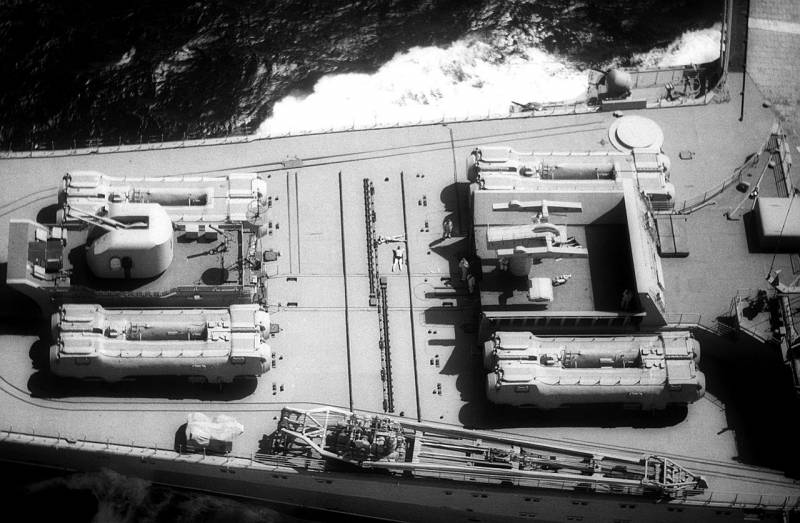
The opportunity to take a fresh look at some problems was partly provided to us by the Armed Forces of Ukraine (AFU), since it was they who clearly demonstrated that even outdated weapon (such as those produced back in the USSR unmanned aerial vehicles (UAVs) Tu-141 "Strizh" and Tu-143 "Flight") can be relatively easily turned into a fairly formidable weapon. Let's see how we can inflict maximum damage on the Armed Forces of Ukraine at minimum cost.

UAV Tu-141 "Strizh" (left) and Tu-143 "Flight" (right)
Anti-ship missiles (ASMs) have always been the basis of the combat power of the Soviet, and then the Russian Naval Fleet (Navy). In the absence of aircraft carriers and deck aviation it was possible to count on the destruction of the mighty American fleet only by delivering a massive strike of anti-ship missiles from surface ships, submarines and naval aircraft. The specifics of the targets being hit, such as aircraft carriers, forced Soviet engineers to create monstrous anti-ship missiles with supersonic flight speeds and a powerful warhead - where is the American Harpoon.
To some extent, the heavy Soviet anti-ship missiles of the P-500 Basalt, P-1000 Vulkan and P-700 Granit projects can be called the “top of the food chain” of their time.
P-500 "Basalt" / P-1000 "Volcano"
Anti-ship missiles of the P-500 Bazalt project were intended for nuclear submarines with cruise missiles (SSGN) of projects 675MK / 675MU, aircraft-carrying cruisers of project 1143 Krechet and missile cruisers of project 1164 Atlant. The P-1000 Vulkan anti-ship missile is a development of the P-500 anti-ship missile, which it replaced on Project 1143 aircraft-carrying cruisers and Project 1164 missile cruisers (RKR).

Project 675 SSGN, Project 1143 aircraft-carrying cruiser and Project 1164 missile cruiser
At present, submarines of projects 675MK / 675MU and aircraft-carrying cruisers of project 1143 "Krechet" have been decommissioned and withdrawn from the Russian Navy. After the tragic death of the flagship of the Black Sea Fleet of the Republic of Kazakhstan "Moskva", two ships of project 1164 remained in service - the flagship of the Pacific Fleet of the RRC "Varyag" and the RRC "Marshal Ustinov" as part of the Northern Fleet.
And if the missile cruiser "Marshal Ustinov" passed in 2011-2016. modernization with the installation of a radar station (radar) "Fregat-M2M", capable of detecting low-flying targets, then the flagship of the Pacific Fleet RRC "Varyag" capabilities in terms of detecting low-flying targets should be comparable to RRC "Moscow".
The problem is that the reason for the death of the Moskva RKR could presumably be the hit of the Ukrainian light low-flying anti-ship missile Neptune, which raises the question of the advisability of these ships being part of the Russian Navy in an unmodernized form. And the potential cost of modernizing rapidly aging ships, comparable to the cost of building new ships of the frigate class, calls into question the feasibility of its implementation.
The ability of the P-500 Bazalt / P-1000 Vulkan anti-ship missiles to withstand modern means of electronic warfare (EW) and anti-aircraft missile systems (SAM) of the enemy is also questionable.
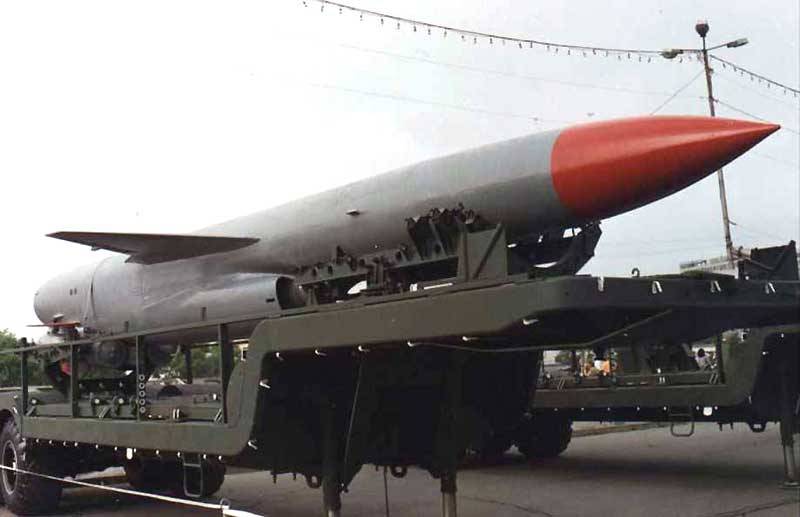
RCC P-500 "Basalt"
Thus, with a high probability, the modernization of the RRC project 1164 will not be carried out in the future. The effectiveness of the ships of this project in the conduct of hostilities against an enemy with modern naval forces (Navy) is extremely doubtful and will decrease in the future, while the cost of operation will only increase. Most likely, the RRC "Varyag" and the RRC "Marshal Ustinov" will finish their lives, performing "ceremonial" functions, and will eventually be decommissioned.
All of the above means that in the foreseeable future, we will have a certain number of anti-ship missiles P-500 "Basalt" and P-1000 "Volcano" out of work.
P-700 "Granite"
The situation with the P-700 Granit anti-ship missiles is in many ways similar. This missile was intended for the SSGN of project 949 "Granit" / 949A "Antey", heavy nuclear missile cruisers (TARKR) of project 1144 "Orlan" and heavy aircraft-carrying cruisers (TAVKR) of project 1143.5.
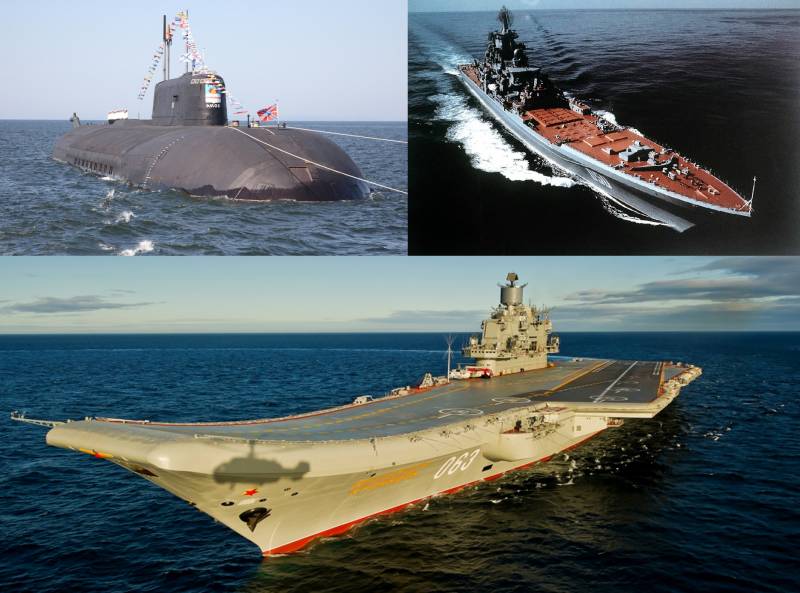
SSGN project 949A, TARKR project 1144 "Orlan" and TAVKR project 1143.5
Both Project 949 submarines have been disposed of, two Project 949A SSGNs have been disposed of, one has been put into reserve before disposal, one, the K-141 Kursk, tragically sank, the entire crew died, four units are in service and more four are being upgraded under project 949AM with the replacement of 24 P-700 Granit anti-ship missiles with 72 Caliber missiles, Onyx anti-ship missiles and the latest Zircon hypersonic anti-ship missiles. Another SSGN of project 949A was completed according to a special project 09852 and will become the carrier of Poseidon strategic torpedoes with a nuclear power plant and a nuclear warhead of increased power.
Of the three Project 1144 TARKRs, two were sent for recycling, one is undergoing a large-scale modernization with a complete replacement of the weapons complex, and the fate of another TARKR of Project 1144.2 "Peter the Great" is in question - for modernization or for disposal, and, judging by the latest information, from -due to the huge costs of modernizing the same type of TARKR "Admiral Nakhimov", the decision leans towards the second option.
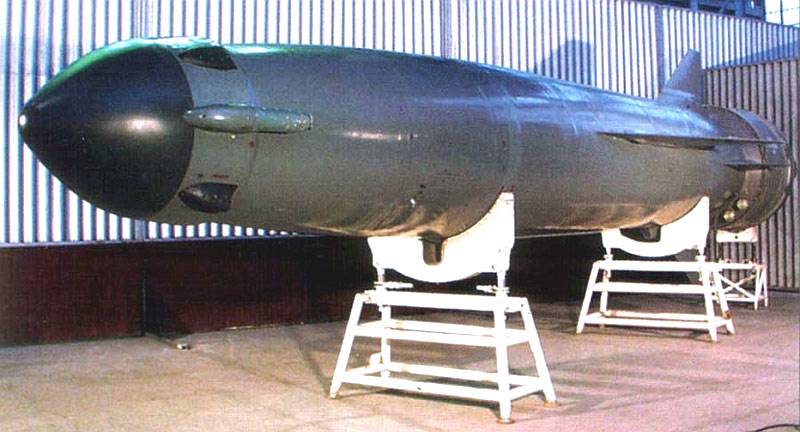
RCC P-700 "Granit"
As for our only aircraft carrier, more precisely the heavy aircraft-carrying cruiser of project 1143.5, the words from the cynical anecdote “buried a stewardess, dug up a stewardess” would be most appropriate here. In any case, if this unfortunate ship is nevertheless decided to be restored and modernized, then it would be a very reasonable decision to dismantle the under-deck launchers (PU) of the P-700 Granit anti-ship missiles in favor of expanding the capabilities of carrier-based aviation.
Thus, from the real carriers of the P-700 Granit anti-ship missiles, we will most likely have only four Project 949A SSGNs, until they are also upgraded according to Project 949AM or sent for disposal, depending on their technical condition .
Based on the foregoing, it can be assumed that as a means of combating the ship or aircraft carrier strike groups of the enemy, the P-700 Granit anti-ship missiles are considered rather on the basis of the principle of "lack of fish and cancer."
Recycling or high performance application?
How many anti-ship missiles of the P-500, P-1000 and P-700 projects were produced?
Most likely, a lot, based on the number of carriers, we should talk about at least hundreds of anti-ship missiles of the P-500 / P-1000 projects, and also, possibly, several thousand anti-ship missiles of the P-700 project. If you roughly estimate - 4 TARKR 1144 + 1 TAVKR 1143.5 + 2 SSGN 949 + 12 (maximum) SSGN 949A = 428 anti-ship missiles in one salvo, that is, 5 ammunition for these ships and submarines is 2 anti-ship missiles.
Of course, here we go into the realm of speculation, since we do not have exact information on the number of these anti-ship missiles, nor is their technical condition known. On the other hand, if the author had accurate information about these anti-ship missiles, then it would hardly be possible to disclose it.
Given the obsolescence of anti-ship missile carriers of the P-500 "Basalt", P-1000 "Volcano" and P-700 "Granit" projects, a variant of their modification for use from ground launchers, for firing at stationary, especially important and fortified targets in the area carrying out the Russian special military operation (SVO) in Ukraine, by analogy with the modification of the outdated Tu-141 Strizh and Tu-143 Reis UAVs carried out by the Armed Forces of Ukraine.
How many anti-ship missiles of the P-500, P-1000 and P-700 projects can be used during the modernization?
Considering that some of the carriers of the P-1000 and P-700 anti-ship missiles are still in service, in any case, part of the Russian Navy will leave them as anti-ship missiles, even if it is reliably known about their low effectiveness against modern ships, however, with special combat part (SBC), they will certainly be much more effective. For our tasks, at a minimum, several hundred missiles of these projects are sufficient.
You can start with the P-500 Bazalt anti-ship missiles, since this missile is considered obsolete, of course, if the anti-ship missiles of this project are still in warehouses in an acceptable technical condition, and then extend the modification program to the P-1000 and P-700.
What improvements should anti-ship missiles of the P-500, P-1000 and P-700 projects undergo when they are modified into long-range cruise missiles (KR BD)?
If possible, it is necessary to do with the minimum number of improvements. First of all, it is necessary installation of an anti-interference signal receiver of the Russian global navigation satellite system GLONASS, to ensure accurate guidance of the modified anti-ship missiles at a stationary ground target in coordinates.
Electronic warfare equipment integrated into anti-ship missiles of projects P-500, P-1000 and P-700 (3B89 / 4B-89 "Shmel" on P-500 and P-1000 and 3B47 "Quartz" on P-700), designed to jam air defense systems it is probably better to leave the enemy, it is possible that they will not deceive modern air defense systems, but after all, the Armed Forces of Ukraine still have a lot of relatively outdated air defense systems, there is no need to make their work easier.
Most likely, it will be necessary to dismantle the active radar homing head (ARLGSN) to accommodate the equipment for entering target coordinates and the GLONASS receiver, just its antenna can be placed under a radio-transparent fairing, and weight reduction can favorably affect flight range.
The high-explosive-cumulative warhead used in the P-500 Bazalt and P-1000 Vulkan anti-ship missiles, weighing about 500–1 kilograms, can potentially be modified to increase the high-explosive effect to the detriment of the cumulative placement of additional fuses, and the semi-armor-piercing high-explosive-penetrating warhead Anti-ship missiles P-000 "Granite" weighing about 700-500 kilograms, most likely, will not require modifications.
And finally, it is necessary to ensure the firing of modified anti-ship missiles from ground launchers, since it is not possible to drag their carriers into the Black Sea. In fact, during the firing tests, the considered anti-ship missiles were previously produced from the surface, for example, the P-500 missile without radio equipment was launched from the SM-49 ground stand.
It can be assumed that there are three options for implementing the launch of the modified anti-ship missiles of the P-500, P-1000 and P-700 projects:
- launch from launchers developed on the basis of ground stands previously used for testing;
- launch from modified launchers dismantled from ships and submarines previously sent for recycling, depending on which option is preferable, provided that they have not yet been cut;
- launch from modified launchers that will be dismantled from ships and submarines that are just about to go for recycling, taking into account the understanding of the need to ensure their safety during extraction.
Why is it necessary to use the Basalt, Vulkan and Granit anti-ship missiles, if we have Caliber, Daggers, Iskanders, various Kh-555, Kh-101 and much more?
Compared to them, long-range heavy cruise missiles based on anti-ship missiles of the P-500 Bazalt, P-1000 Vulkan and P-700 Granit projects have a number of advantages.
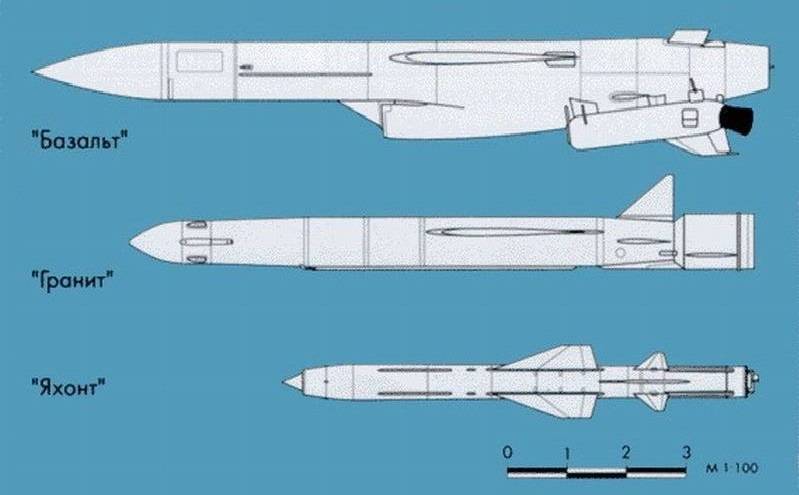
Comparison of the dimensions of the anti-ship missiles "Basalt", "Granite" and "Yakhont" (P-800 "Onyx"). Image paralay, forums.airbase.ru
The mass of the anti-ship missiles under consideration is approximately 7–8 tons, which is approximately 1,5–2 times the mass of most cruise and ballistic missiles used by the RF Armed Forces. These missiles contain a powerful warhead and develop a flight speed of up to 2,5 M at altitude, which is significantly higher than the flight speed of subsonic missiles of the Caliber complex, Iskander-K missiles, as well as Kh-555 and Kh-101 missiles. When delivering strikes at a distance less than the maximum, the impact of burning fuel will be added to the destructive force of the strike - many remember the effect it had on the structure of the American twin towers rammed by passenger planes.
The combination of a powerful warhead, massive hull and high speed will make it possible to inflict significant damage on such objects that are difficult to destroy, such as railway bridges and industrial enterprises.
Modification of anti-ship missiles of projects P-500, P-1000 and P-700 in the KR database is a simpler, cheaper and faster alternative creation of "aircraft-shells" based on obsolete aircraft и intercontinental ballistic missiles (ICBMs) with a conventional warhead.
Of course, this alternative should not cancel, but only complement and anticipate the emergence of other previously considered types of long-range precision weapons with a warhead of increased power - there are still many objects in the world that need not only be damaged, but demolished to the ground.
At the same time, in connection with the disposal of their carriers or their modernization for new weapons systems, the Basalt, Vulkan and Granit anti-ship missiles in the near future will still remain ownerless and rot in warehouses.
It is possible to place launchers, presumably, in the Crimea and in the Bryansk region. In this case, they will be difficult to reach for the enemy, while with a flight range of 500 kilometers, the entire left-bank Ukraine will be shot through, and with a range of 1 kilometers, all of Ukraine and a significant part of Poland in general.
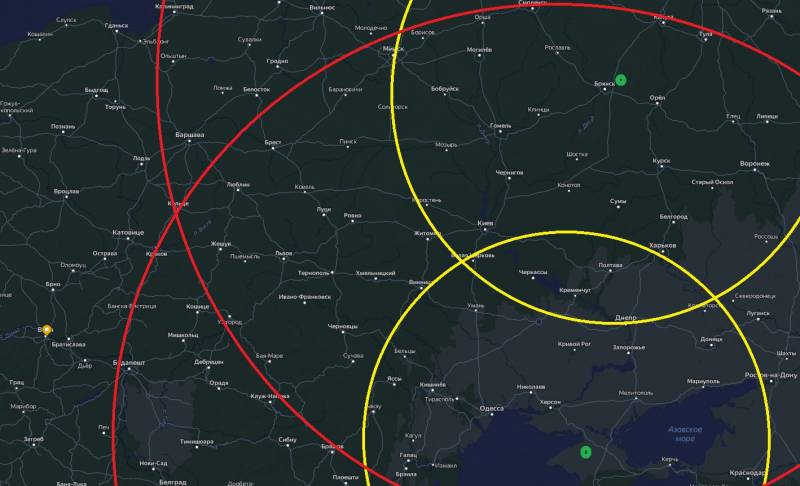
The conditional location of the launchers (indicated in green); (indicated in yellow on the map) approximate reach zones for a range of 500 kilometers, red color - approximate reach zones for a range of 1 kilometers
For what purposes can the KR BD based on the Basalt, Vulkan and Granit anti-ship missiles be used?
Of course, first of all, on the cascade of transport facilities on the Dnieper - yes, we are again returning to the topic discussed in the material By destroying transport facilities across the Dnieper, it is possible to denazify half of Ukraine before the end of this year in September 2022 of the year.
Of course, by the end of 2022 it will definitely not be possible to denazify half of Ukraine, but by the end of 2023 you can try, provided that the bridges across the Dnieper are still destroyed.
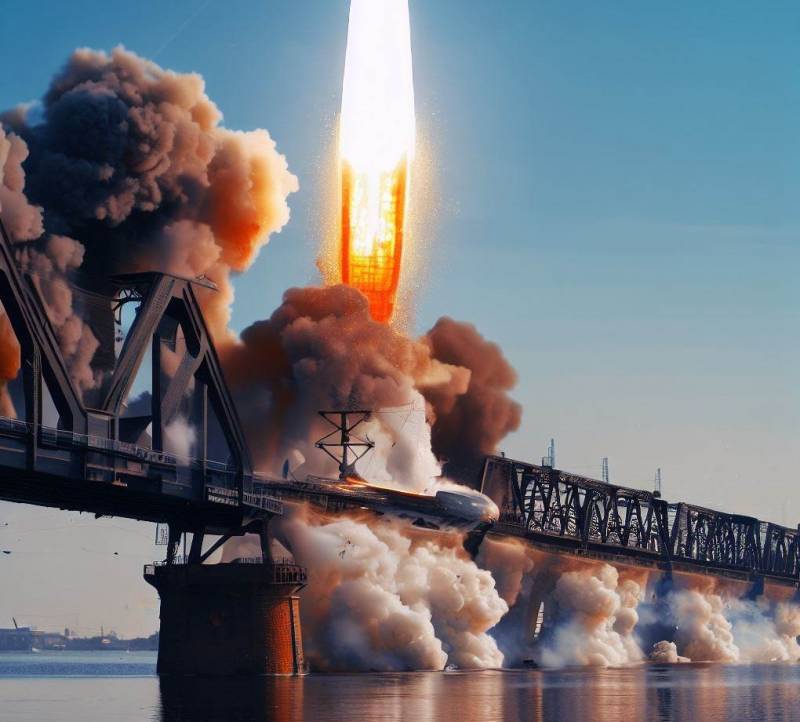
The destruction of railway bridges on the Dnieper is vital to ensure victory in the NWO
In second place are industrial enterprises, enterprises of the military-industrial complex of Ukraineproducing weapons for the Armed Forces of Ukraine, including unmanned boats that can be used against the Black Sea Fleet of the Russian Navy or against the Crimean Bridgeand decision centers.
Well, infrastructure is in third place - road and rail bridges, large power substations, fuel storage facilities, databases (HLR) and mobile switching centers (MSC) of mobile operators.
Ultimately, the choice of targets will directly depend on how much anti-ship missiles will be converted into BR DB.
How many anti-ship missiles "Basalt", "Volcano" and "Granit" need to be modified in the CD DB for use during the NWO?
Of course, the more the better. You can leave one ammunition load per active carrier, and a certain amount for training / test launches, and put the rest into action. It can be assumed that even a hundred KR BDs based on the Basalt, Vulkan and Granit anti-ship missiles will completely destroy the cascade of transport facilities on the Dnieper and ensure Russia's quick capture of the territory of the left-bank Ukraine, and a thousand of these missiles will achieve much more.
Conclusions
The value of anti-ship missiles of the projects P-500 "Basalt", P-1000 "Volcano" and P-700 "Granite" as a means to destroy enemy ships will inevitably and rapidly decrease, it is possible that their effectiveness for solving this problem is no longer high enough.
The number of carriers of these anti-ship missiles will inevitably decrease, it is possible that the principle “no missiles - no carrier is needed” will rather benefit the Russian Navy, facilitating the adoption of difficult decisions such as “modernize or dispose of”, freeing up resources and, as a result, updating the ship’s composition Russian Navy.
At the same time, the modification of anti-ship missiles of the P-500 Bazalt, P-1000 Vulkan and P-700 Granit projects into long-range cruise missiles designed to hit especially important targets will allow the Russian Navy to play a much greater role in the course of the NWO , and possibly inflict critical hits on the enemy, necessary to achieve victory.
And finally, the use of the KR DB based on the Basalt, Vulkan and Granit anti-ship missiles will allow the Russian Navy to "get even" with the Armed Forces of Ukraine for the Moskva missile cruiser, for escape from the island "Snake", for sabotage on the Crimean bridge and incessant attacks on ships of the Black Sea Fleet.
Information